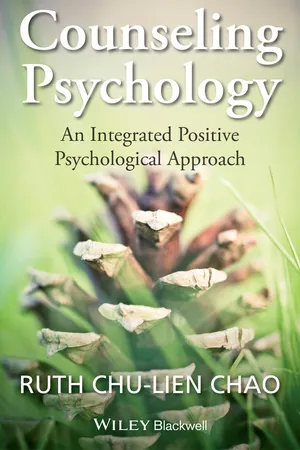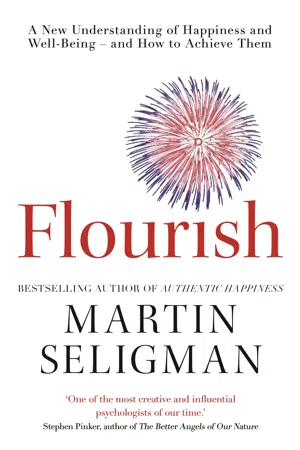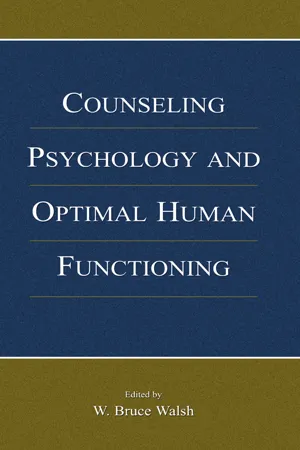Psychology
Positive Psychology Therapy
Positive Psychology Therapy focuses on promoting well-being and happiness by emphasizing an individual's strengths and virtues. It aims to cultivate positive emotions, enhance resilience, and foster a sense of fulfillment and meaning in life. This therapeutic approach encourages clients to focus on their potential for growth and to develop strategies for building a more satisfying and meaningful life.
Written by Perlego with AI-assistance
Related key terms
9 Key excerpts on "Positive Psychology Therapy"
- eBook - ePub
Positive Art Therapy Theory and Practice
Integrating Positive Psychology with Art Therapy
- Rebecca Ann Wilkinson, Gioia Chilton(Authors)
- 2017(Publication Date)
- Routledge(Publisher)
as a result of them . In fact, one could paradoxically be quite ill and impaired in some ways and yet thriving in others.Disconcerted but also intrigued by the disruption of some of our fundamental assumptions about therapy, change, and human nature, we set about exploring positive psychology more deeply. This included looking at current literature in positive psychology, but also relevant material emerging in art therapy, education, and other related fields. It also involved looking back over the historical context surrounding the formation of this “new” field and the theoretical foundations upon which it is grounded.In the next few chapters, we share some of what we discovered. We have tried to distill what, for us, has taken over ten years to learn. For some of you, this material may be redundant. On the other hand, perhaps it can serve as a useful refresher and set the stage for exploring art therapy from a positive psychology perspective. We felt that that could best be done by first describing the circumstances around which positive psychology emerged. Especially because, despite being seasoned clinicians as well as art therapy educators ourselves, we were often surprised by gaps in our knowledge or misconceptions that we had about the historical, social, economic, cultural, and political factors that led to development of different psychological schools of thought and that shaped mental health practices today, in general, let alone in the field of positive psychology.p.10 Positive Psychology DefinedPositive psychology, also known as the science of wellbeing , is the study of human potential and optimal functioning. It is an in-depth exploration of the conditions and processes that allow individuals and communities to flourish and thrive (Seligman & Csíkszentmihályi, 2000). The field was christened in 1998 when Martin Seligman (1999), in his role as the president of the APA, identified that although we had made tremendous advances in understanding mental illness and reducing suffering, we had not devoted equal resources to exploring what is positive and functional in our lives. Positive psychologists have set about correcting this imbalance—not to diminish or replace the importance of addressing and attending to pathology and pain—but to complement this with an exploration of healthy, adaptive functioning. They wanted to establish for mental health the same depth and breadth of research, theory, and practical application as has been done for mental illness - eBook - ePub
Counseling Psychology
An Integrated Positive Psychological Approach
- Ruth Chu-Lien Chao(Author)
- 2015(Publication Date)
- Wiley-Blackwell(Publisher)
PART II Integration of Counseling Theories and Positive PsychologyPassage contains an image
4 Positive Psychology in Counseling : What is it?
Learning Objectives
- Define positive psychology.
- Explore the historical background of positive psychology.
- Examine the theoretical principles of positive psychology.
- Consider positive psychology in a multicultural context.
Positive psychology, as a subfield in psychology, is an approach that focuses on the positive aspects of human beings, such as strengths and virtues, as opposed to the deficit-repair model of psychotherapy. Positive psychology embraces the study of the processes and conditions that contribute to optimal functioning and flourishing in human beings. Topics in positive psychology include at least three areas: (a) the study of positive emotions, such as well-being, hope, curiosity, and love; (b) the study of individual strengths, such as problem-solving skills, wisdom on living in general, and courage in face of threatening adversity; and (c) the study of positive practices in institutions, such as school policies that foster students’ intrinsic motivation to learn. Although interest in such topics has existed since the earliest days of psychology, the term and concept of positive psychology were coined as part of a concentrated effort by psychologists who saw a need to highlight these relatively neglected areas of research.An important impetus for the emergence of positive psychology came from the reaction to the dramatic increase in attention devoted to the understanding and treatment of psychopathology, and to the biological and environmental factors contributing to mental illness (Seligman & Csikszentmihalyi, 2000). Positive psychology, as a focus of study, arose as a concerted and coordinated effort to promote theoretical and research attention toward psychological functioning at its best (Keyes, 2002). Thus, positive psychology creates a better balance with the work being done on mental illness. - eBook - ePub
Positive Psychology
The Basics
- Rona Hart(Author)
- 2020(Publication Date)
- Routledge(Publisher)
positive psychiatry has been coined to capture the wealth of positive concepts and interventions that can be included in psychiatric work (Palmer, 2015). Similarly, in health psychology researchers have incorporated positive psychology interventions, typically including gratitude, optimism, hope, kindness and mindfulness, into health psychology practice, with some promising outcomes in patients with a variety of illnesses, including cancer, cardiovascular disease and diabetes (Macaskill, 2016).Is positive psychology a discipline, a collective identity, an ideology or a social movement?In the early years following its launch Linley and Joseph (2004b) debated whether positive psychology is a new sub-discipline within psychology, and argued that positive psychology should be seen as a “collective identity” that brings under its auspices researchers from varied disciplines who are interested in “the brighter sides of human nature” (p. 4). As such, it can be seen as an ethos and a set of concepts and tools that can be adopted and applied by scholars or practitioners in any psychological field.However, in view of the progress described above, Lomas and Ivtzan (2016) assessed that positive psychology has become a distinct applied discipline within psychology, which requires appropriate recognition and accreditation that will signify the professional identity of those who conduct research, teach and facilitate its interventions.Another common description of positive psychology is that of movement which aims to challenge the status quo, and hence carries an ideological stand-point as to what psychology should focus on (Peterson & Park, 2003). In line with this perception, Biswas-Diener, Linley, Govindji, and Woolfston (2011) described positive psychology as a force for social change, and positive psychology practitioners as transformative activists. - eBook - ePub
Art Therapy and Career Counseling
Creative Strategies for Career Development Across the Lifespan
- Barbara Parker-Bell, Debra Osborn(Authors)
- 2022(Publication Date)
- Routledge(Publisher)
8 Positive Psychology in Career Development and Art TherapyEmphasizing StrengthsDOI: 10.4324/9781003035756-8In this chapter, career concerns will be addressed through positive psychology and positive art therapy lenses. Highlighted concepts will include benefits of generating hope, identifying strengths and resources, and cultivating meaning and purpose in the occupational realm. Additionally, examples of career development strategies and art-based interventions will be described. Positive psychology, art therapy, and career counseling concepts and tactics will be applied to various career stages such as early career preparation; transition from school to the world of work; transforming mid-career workplace challenges; and late career challenges and transitions including retirement. Examining and applying identified strengths will be a primary emphasis.Positive Psychology
In recent years, positive psychology concepts originated by Seligman and Csikszentmihalyi (2000) have grown in popularity and inform many helping professions’ orientation to improving client well-being and functioning in various life realms including career domains (Panc, 2015 ). Seligman and Csikszentmihalyi described positive psychology as the study and cultivation of human flourishing and personal fulfillment in contrast to disease-oriented models of psychology which have focused on pathology, repair, and amelioration of distress. Efforts in positive psychology practice aim to stimulate change through fostering positive subjective experiences and attending to positive traits, strengths, and virtues. Positive traits enumerated by Seligman and Csikszentmihalyi include personal courage, perseverance, originality, aesthetic sensibility, and wisdom, among others, notably “capacity for love and vocation” (Seligman & Csikszentmihalyi, 2000 - eBook - ePub
Well-Being in Adolescent Girls
From Theory to Interventions
- Elena Savina, Jennifer M. Moran(Authors)
- 2021(Publication Date)
- Routledge(Publisher)
4) Positive psychology became the study of the strengths and virtues that allow both individuals and communities to thrive (Seligman & Csikszentmihalyi, 2000). Seligman (2002) further proposed a concept of positive mental health that delineated human flourishing and living a fulfilled life. This concept places human functioning on a continuum, with mental illness representing one end of the continuum and optimal psychological health the other. Human well-being became a central concept in positive psychology (Seligman, 2011). The construct of well-being defies precise definition. Rather, it encompasses a broad range of characteristics and processes related to human optimal psychological functioning. Well-being is not synonymous with happiness, though the experience of happiness is important for well-being. It includes an individual’s strengths and virtues, meaning, purpose, and life satisfaction. It is further concerned with identifying outcomes of well-being for overall human functioning and conditions that can promote or undermine well-being. The latter is especially important for designing well-being interventions. The study of well-being in psychology stems from two philosophical traditions: one emphasizing the pursuit of pleasure and life satisfaction (hedonic well-being) and the other emphasizing the pursuit of a meaningful life and optimal functioning (eudaimonic well-being; Ryan & Deci, 2001). While hedonic and eudaimonic perspectives represent two distinct understandings of well-being, experiences of pleasure and living a meaningful life are related. Individuals experience positive emotions in response to meaningful achievements, and these positive experiences likely lead to the pursuit of meaningful and fulfilling opportunities in the future. Thus, the hedonic and eudaimonic perspectives are in many ways complementary - Alex M. Wood, Judith Johnson(Authors)
- 2016(Publication Date)
- Wiley-Blackwell(Publisher)
Well-being therapy (Fava, 1999) developed in a clinical setting and originated from the growing awareness that standard treatments for mood and anxiety disorders were not sufficiently effective in determining full recovery. A substantial residual symptomatology has been found to characterize the majority of patients who were judged to be remitted according to standard criteria. These residual symptoms may progress to become prodromes of relapse (Fava, Ruini, & Belaise, 2007). As a result, the challenge of treatment of mood and anxiety disorders appeared to be the prevention of relapse more than the attainment of recovery (Fava & Tomba, 2010; Fava, 2013). The absence of psychological well-being has been found to be a risk factor for depression (Wood & Joseph, 2010). Thunedborg, Black, and Bech (1995) observed that quality of life measurement, and not symptomatic ratings, could predict recurrence of depression. An increase in psychological well-being may thus protect against relapse and recurrence (Wood & Joseph, 2010). Further, many investigations in psychosomatic settings provided confirmation of the protective role of well-being, both for mental and for physical health. Positive emotions and well-being, with the contribution of other factors, can influence the healing process of various diseases (Chida & Steptoe, 2008; Fava & Sonino, 2010; Ryff, 2014).However, an intervention that targets the positive may address an aspect of functioning and health that is typically left unaddressed in conventional treatments. As early as 1954, Parloff, Kelman, and Frank suggested that the goals of psychotherapy were increased personal comfort and effectiveness, and humanistic psychology suggested concepts such as self-realization and self-actualization as final therapeutic goal. For a long time these latter achievements were viewed only as by-products of the reduction of symptoms or as a luxury that clinical investigators could not afford. This probably is due to the fact that, historically, mental health research has been dramatically weighted on the side of psychological dysfunction, and health was equated with the absence of illness, rather than the presence of wellness (Ryff & Singer, 1996). In 1991, Garamoni and colleagues suggested that healthy functioning is characterized by an optimal balance of positive and negative cognitions or affects, and that psychopathology is marked by deviations from the optimal balance.Positive interventions, thus, should not be simply aimed to increase happiness and well-being, but should consider the complex balance between psychological well-being and distress (MacLeod & Moore, 2000) and be targeted to specific and individualized needs. Wood and Tarrier (2010) emphasize that positive characteristics such as gratitude and autonomy often exist on a continuum. They are neither “negative” or “positive”: their impact depends on the specific situation and on the interaction with concurrent distress and other psychological attitudes.All these elements should be taken into account in the psychotherapy process. Well-being therapy is a psychotherapeutic intervention that takes into consideration the above concepts for achieving a balanced and individualized path to optimal functioning.- eBook - ePub
- Acacia Parks(Author)
- 2014(Publication Date)
- Routledge(Publisher)
Sue (2003) notes that some of the skills or strengths that may develop for people who overcome racial or cultural adversity include heightened perceptual wisdom (i.e., the ability to correctly perceive underlying motives, intentions, and meanings of others), the ability to rely on non-verbal or contextual meanings, and bicultural flexibility (i.e., openness to multiple worldviews, sensitivity to other’s viewpoints, and behavioral flexibility). Such flexibility often leads to a broadened world view, an appreciation for the strengths and weaknesses of all people, comfort with cultural differences and better effectiveness in relating to those of diverse backgrounds, an enhanced sense of self-fulfillment, and a sense of connection and commitment to better citizenship and social responsibility.Positive psychology can also be applied within courses on multiculturalism through such exercises as having students examine all aspects of their own cultural identities via use of the ADDRESSING model (Hays, 1996, 2001). ADDRESSING is an acronym, with each letter representing one aspect of culture as follows: Age and generational influences, Disability status (developmental), Disability status (acquired), Religion and spiritual orientation, Ethnicity, Sexual orientation, Socioeconomic status, Indigenous heritage, National origin, and Gender. Students should be challenged to consider what personal strengths, interpersonal supports, culturally-related knowledge and skills, and environmental strengths have developed for them due to their cultural make-up.Positive psychology in introduction to counseling skills and techniques coursesPositive psychology can be incorporated into counseling skills courses in some of the same ways as previously noted within the contexts of abnormal psychology or psychological assessment classes. More specifically, people-first language, the four-front assessment approach (Wright & Lopez, 2002), and the complete state model of mental health (Keyes & Lopez, 2002) are all applicable to counseling. Several other concepts from positive psychology also have applicability when it comes to teaching students basic counseling skills, including active-constructive responding (Gable, Reis, Impett, & Asher, 2004), positive empathy (C.W. Conoley & J.C. Conoley, 2009), and highlighting client strengths and resources throughout the counseling process.According to Gable et al. (2004), there are four possible ways in which one can respond to the good events in the lives of those with whom one interacts: (1) active-constructive (responding enthusiastically); (2) passive-constructive (happy, but downplayed); (3) active-destructive (pointing out the downside); (4) passive-destructive (lacking interest). Of the four styles, only the active-constructive style benefits both the individual one is interacting with, as well as the relationship between the two parties. Students should be exposed to the idea of active-constructive responding and encouraged to respond in this manner to the good news, positive experiences, and victories that they hear in the stories that their clients tell. Indeed, responding in this manner serves to strengthen the ever-important working alliance within the therapeutic relationship. - eBook - ePub
Flourish
A New Understanding of Happiness and Wellbeing: The practical guide to using positive psychology to make you happier and healthier
- Martin Seligman(Author)
- 2011(Publication Date)
- Nicholas Brealey Publishing(Publisher)
When I started out as a therapist almost forty years ago, it was common for my patient to tell me, “I just want to be happy, Doctor.” I transformed this into “You mean you want to get rid of your depression.” Back then I did not have the tools of building well-being at hand and was blinded by Sigmund Freud and Arthur Schopenhauer (who taught that the best humans can ever achieve is to minimize their own misery); the difference had not even occurred to me. I had only the tools for relieving depression. But every person, every patient, just wants “to be happy,” and this legitimate goal combines relieving suffering and building well-being. Cure, to my way of thinking, uses the entire arsenal for minimizing misery—drugs and psychotherapy—and adds positive psychology.Here then is my vision of the therapy of the future, my vision for cure.First, patients need to be told that the drugs and therapies are temporary symptom relievers only, and that they should expect recurrence when treatment stops. Hence, explicit, successful practice in dealing with it and functioning well even in the presence of the symptoms must be a serious part of therapy.Second, treatment should not end when suffering is relieved. Patients need to learn the specific skills of positive psychology: how to have more positive emotion, more engagement, more meaning, more accomplishment, and better human relations. Unlike the skills of minimizing misery, these skills are self-sustaining. They likely treat depression and anxiety and they likely help prevent them as well. More important than relieving pathology, these skills are what flourishing is, and they are crucial to everyone’s search for well-being.But who will disseminate these skills to the world?Applied Psychology Versus Basic Psychology: Problems Versus Puzzles
When the University of Pennsylvania’s top administration was debating in 2004 whether to offer a new degree in order to cash in on the public demand for positive psychology, the dean of natural science said, with a touch of venom, “Let’s make sure we put an A in it. After all, it is the psychology department that does the pure science, and we wouldn’t want people to be confused, would we?”“Will Professor Seligman go along?” wondered the dean of social science. “It is sort of insulting.An A - W. Bruce Walsh(Author)
- 2014(Publication Date)
- Routledge(Publisher)
We have focused most of this chapter on strengths in the client, but it is also important for therapists (and supervisors) to attend to the therapist’s own strengths, as well as to those of their clients. It is easy for therapists to forget their own competencies at times. Therapists may neglect to consider the full range of interventions they are capable of providing with clients, due to countertransferential or other issues. At such times, therapists may appear limited in the type of responses they are able to offer the client. There may be a tendency for the therapist or supervisor to focus on this limitation as a weakness, without calling to mind strengths that the therapist has available for use in remedying the problem. For example, a therapist may unintentionally overidentify with a client’s own sense of fragility and brittleness and fail to be sufficiently challenging to the client despite the fact that the client has given evidence of being stronger than the client him or herself may be aware of. The therapist is more likely to be successful in changing the pattern of insufficient challenging with the client if he or she remembers that there have been some occasions when it was possible to be appropriately challenging with clients. The therapist could focus attention on situations with other clients, or perhaps even with the same client, in which the therapist was able to be effectively challenging, using empathy to effectively balance challenge and support. This focus on therapist strength can be useful for therapists at all levels of experience, but it is particularly relevant for the training and supervision of new therapists. For example, supervisors can explicitly point out supervisee strengths, can offer confrontations to the supervisee that are based on supervisee strengths, and can comment on small steps in the right direction. Supervisors can attempt to engage in a parallel process with their trainees, in which supervisors keep a focus on trainees’ strengths and competencies, and attempt to build on those, much as trainees are working to notice and enhance client strengths.In summary, there are a number of ways that clinicians can incorporate a conceptualization of client strengths into what they say and do in therapy. They can explicitly comment on client strengths, including strengths that emerge in the context of the therapy relationship. Therapists can also reframe apparent weaknesses as strengths, or attend to strengths that are embedded in defenses. Therapists can incorporate an empathic understanding of the client’s culture into the interpretation of client strengths, as well as into choices about how to work with client strengths based on cultural considerations. And finally, supervisors of therapists can consciously engage in a parallel process of focusing on strengths in the supervision, just as therapist trainees are focusing on client strengths in the clinical hour.Research Agenda for a Positive PsychotherapyEmpirical research on the positive in psychotherapy may usefully address at least two general levels. The first is the constructs that are framed and studied, whereas the second level pertains to the effects of positive tactics on process and outcome. Next we shall briefly address each of these levels.The constructs that are studied in psychotherapy, both as outcomes and as moderators or mediators of outcome have predominantly reflected psychopathology and its elimination. For example, typical outcomes studied are the reduction in symptoms, disorders, or ineffective behaviors. The study of the effects of therapy on such negative qualities is certainly important and relevant, and we think it needs to continue. At the same time, human strengths—the positive qualities that we as therapists also seek to enhance—must also be studied. Although outcome research in counseling psychology has probably addressed these positive qualities more than is the case in other fields, such qualities have been mostly ignored in all fields or specialties that study psychotherapy.
Index pages curate the most relevant extracts from our library of academic textbooks. They’ve been created using an in-house natural language model (NLM), each adding context and meaning to key research topics.








